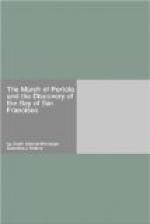Vizcaino’s rose-colored report did not deceive the authorities, but as he had the necessary outfit and had had some experience, the Council decided that he was the best man to head the expedition, though Zuniga favored Don Gabriel Maldonado, of Saville, for commander. The Council ordered that Vizcaino be supplied from the royal treasury with all necessary funds; it granted the boon of encomienda for three lives, and that the discoverers should have all the privileges of gentlemen throughout the Indies. It also granted other minor privileges and boons asked for. Vizcaino was made captain-general of the expedition, and sailed from Acapulco May 5, 1602, with orders to explore the coasts of the Californias from Cape San Lucas to Cape Mendocino, or as far north as latitude forty-two. His ships were the San Diego, flagship, the Santo Tomas, under Toribio Gomez de Corvan, the Tres Reyes, a small fragata or tender, under Alferez Martin Aguilar, and a barcolongo for exploring rivers and bays[4]. The chief pilot of the expedition was Francisco Bolanos who had been one of the pilots with Cermenon on the lost San Agustin. Three barefooted Carmelites looked after the spiritual needs of the adventurers. The story of this second voyage of Vizcaino is well known. On the 10th of November, they were in the Bay of San Diego, which Vizcaino named for San Diego de Alcala, whose day, November 14th, they spent in the bay, ignoring the name, San Miguel, given it by Cabrillo sixty years before. Later in the month he entered and named San Pedro bay, for Saint Peter, bishop of Alexandria, whose day, November 26th, it was. He also named the islands still known as Santa Catalina and San Clemente. He next sailed through and named the Canal de Santa Barbara, which saint’s day, December 4th, was observed while in the channel, and also named Isla de Santa Barbara and Isla de San Nicolas. Passing Punta de la Concepcion, which he named[5], Vizcaino sailed up the coast in a thick fog, which lifting on December 14th, revealed to the voyagers the lofty coast range usually sighted by the ships coming from the Philippines. Four leagues beyond they saw a river flowing from high hills through a beautiful valley to the sea. To the mountains he gave the name of Sierra de la Santa Lucia, in honor of the Saint whose day (December 13th) they had just celebrated, and the stream he named Rio del Carmelo, in honor of the Carmelite friars. Rounding a high wooded point, which he named Punta de los Pinos, he dropped anchor in Monterey bay, December 16th, 1602. Here Vizcaino found the much desired harbor of refuge, and he named it for his patron, the Conde de Monterey. Vizcaino made the most of his discovery, and in a letter to the king, written in Monterey Bay, December 28, 1602[6], he gives a most glowing description of the bay, which is, at best, but an open roadstead. The Indians, as usual, told him of large cities in the interior, which they invited him to visit, but Vizcaino could not tarry. His provisions were




